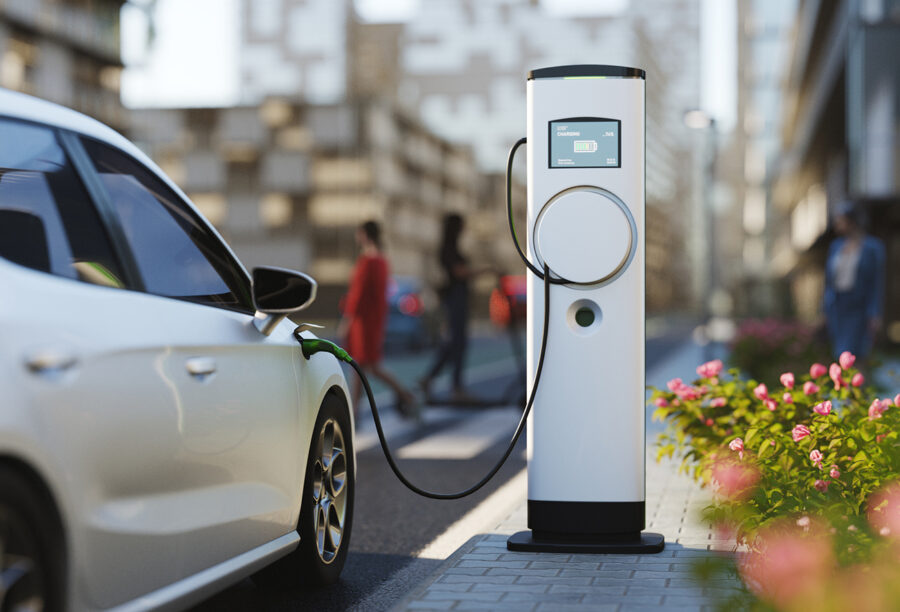Wharton management professor John Paul MacDuffie is encouraged by a new Bloomberg analysis that indicates the U.S. has reached a tipping point in the sale of electric vehicles, and he says more signposts are guiding Americans toward widespread EV adoption.
The analysis, which was published last month, finds that the sale of electric vehicles follows the same S-shaped curve as other successful new technologies, such as smartphones, laptops, and LED lightbulbs. Sales are slow until the number hits 5%, then take off as customers rapidly convert to the new product.
In the last quarter of 2021, the United States joined a list of 18 other countries to surpass the 5% sales threshold for EVs, which Bloomberg concludes is a harbinger of things to come. For countries that previously crossed the threshold, including Norway, South Korea, the U.K., and Germany, EV sales now account for as much as 83% of all cars sold.
But MacDuffie, who is also director of the Program on Vehicle and Mobility Innovation at Wharton’s Mack Institute for Innovation Management, said it’s more than just a statistical pattern that matters in the U.S. A combination of regulatory changes and financial incentives are helping accelerate EV adoption here, he noted.
“We have a lot of enabling factors that maybe will make the U.S. fit this pattern that has shown up in so many other countries,” MacDuffie said during an interview with Wharton Business Daily on SiriusXM.
Overcoming Barriers
The lack of charging infrastructure and the high price of electric vehicles are among the biggest barriers to widespread adoption, MacDuffie said. But relief is on the way. He pointed to the Inflation Reduction Act, which passed the House last week and was signed into law Tuesday by President Joe Biden, as an example. It includes expanded tax credits for EVs and additional federal funding for charging stations across the country. The bipartisan Infrastructure Investment and Jobs Act that was signed into law earlier this year provides $7.5 billion for a network of charging stations.
“There are many factors, but instead of these looking insurmountable like they would prevent a tipping point, they now look like hard problems that maybe will start to be solved little by little until it just accelerates the diffusion trend,” MacDuffie said.
“To me, perhaps the most important thing is the momentum there. Are the set of drivers strong enough and resilient enough to hit some bumps and keep going?” — John Paul MacDuffie
Beyond financial incentives, he said, there has to be a certain amount of peer pressure to get Americans to abandon their gas-powered cars and trucks. He expects that will happen as more automakers build EVs for more consumers across different price points.
“Public perception is important,” he said. “When you see your neighbors installing a straightforward charging station at home, and a few other neighbors do the same, and they’ve got a shiny new EV in their driveway, that’s the kind of thing that gets those peer pressures, those social forces behind it.”
What About Supply Chain Shortages?
MacDuffie is also encouraged by innovation in battery chemistry and the announcement to begin manufacturing more semiconductor chips in the U.S., moves that should further help EV market penetration. Supply chain shortages persist, but business leaders are working to address problems.
MacDuffie said he recently spoke with the CEO of ChargePoint, a private company building a network of charging stations in North America and Europe, who envisions enough charging ports so that people can “top off” their batteries while grocery shopping or running other errands. It’s an untapped market that’s ripe for exploration, he said, mentioning how Sheetz partnered with Tesla in 2012 to build charging stations at its convenience stores.
“They saw it as a business opportunity, and now they have some of the highest density of chargers around,” he said.
The Bloomberg analysis also found that sales for plug-in hybrids, which use both batteries and gasoline, take off at about 10%. MacDuffie said that indicates how consumers think of plug-in hybrids as “transitional technology” as they move toward fully electric vehicles. It’s yet another sign of where the market is headed.
“There are so many things that can slow momentum or speed it up, and those will have all the difference in reaching those big ambitious goals,” he said. “To me, perhaps the most important thing is the momentum there. Are the set of drivers strong enough and resilient enough to hit some bumps and keep going? I have more confidence that that is true now.”



